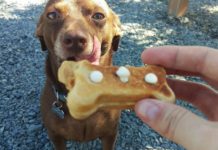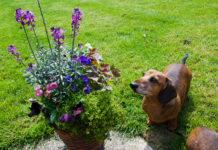Top 10 Tips for Best Results
- Keep your training sessions short. 10 – 15 minutes of good practice a few times a day is great. Try to end your training sessions on a positive note and before your dog gets tired. Leave him wanting more for the next session.
- The tone of your voice is important. When you give your dog a cue to perform, it should be in a very happy, upbeat tone. Nobody likes being told what to do in a demanding or dull tone. When you give praise it should be even happier and more upbeat. Really make the dog know how well he did. If you choose to give a correction, the tone of your voice should be low, stern yet calm. No yelling or screaming, please!!
- Don’t always be predictable in your training sessions. Dogs learn patterns very well. They start to pick up on things like: always performing the training sessions at the same time, or in the same manner, or after you perform a certain activity or even if you always begin by standing in a certain way. The goal is to train your dog to listen to you at all times, not just when he knows he’s being trained.
- Take a break if you start to feel frustrated. Training your dog should be a fun way to interact with him and teach him new things. If you’re becoming anxious because he is a little less successful than you’d like, take a break for awhile and come back later. You’ll be surprised how much better the next training session is.
- The timing of your reward is very important. Make sure you use it at the exact second your dog does the behavior your want. Example, when teaching the Sit behavior, as soon as he places his back-end on the ground, reward him!
- If you want your dog to behave in all different types of situations, you have to train in those situations. Dogs don’t “generalize” well. When training your dog, you want him to learn that the cues you give him (sit, come, down, etc…) mean the same thing no matter where he is. This is called generalization. Dogs don’t understand this concept at first. When learning a new cue, they may only perform the requested behavior when they’re in the exact setting that they initially learned it (for example, next to the sofa with you standing in front of them). Teach them “Sit” means “Sit” everywhere by teaching it in the following contexts:
- Different areas/rooms of your house, outside, other places, etc…
- While you’re sitting down, standing up off to the side, lying down…
- With you looking away from them, while you’re eating, drinking, etc…
- Basically any different position or situation you can think of that you will want you’re dog to respond in
- Always take the time to reward good behavior. Show your dog how much you like it when he is behaving nicely, such as lying down and/or playing calmly with a nice chew toy for example. Take the time to point out when he is being good and give him lot of praise and petting when he does the right thing all on his own.
- Don’t reward bad behavior. Dogs do what works. If they know, for example, that barking for a cookie or performing some other form of inappropriate behavior always results in them getting some type of reward, they’ll keep doing it. Don’t give in to attention-seeking behavior. Try to figure out what the dog’s purpose is in doing the inappropriate behavior and take steps to stop it.
- Try to treat the cause of a problem behavior and not the symptom. Problem behaviors can have one or many “roots “to the actual problem. Try to attack the root of the problem and not just the surface. For example, pulling on leash is a problem caused because the dog has never been shown how to properly walk on leash. He has also always been rewarded (see above) for pulling by us because we keep allowing him to pull us where he wants to go. Once you’ve identified the “root” of the problem, you can work on its solution.
- Treat problem behaviors by thinking in a positive context instead of a negative one. Instead of thinking how you can get your dog to stop doing a particular problem behavior, try to think of ways he can perform an alternate acceptable behavior. For example, instead of thinking how you can get your dog to stop chewing on your furniture, try to think of ways you can get him to chew on acceptable items such as Kongs and Nylabones. This puts a more positive spin on the problem, allows you to understand his needs somewhat, and builds a stronger bond with him.
Most Importantly… Have Fun!!!











